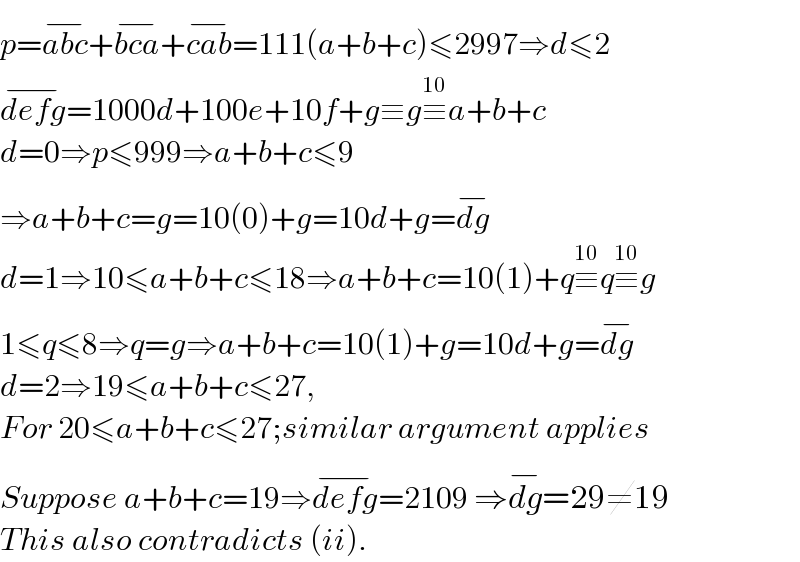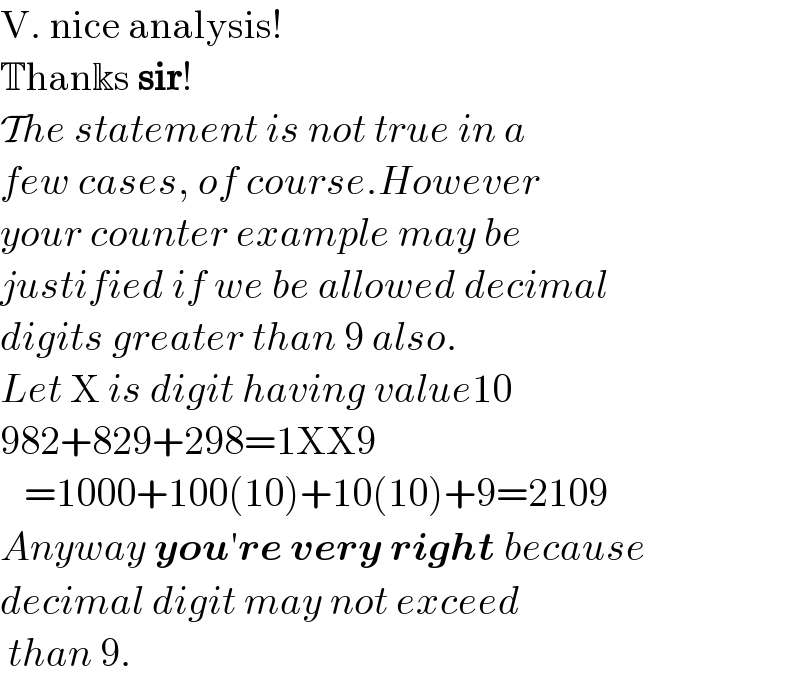
Question Number 200836 by Rasheed.Sindhi last updated on 24/Nov/23

$$ \\ $$$$\mathcal{L}{et}\overline {\:{abc}\:}+\overline {\:{bca}\:}+\overline {\:{cab}\:}=\overline {\:{defg}\:} \\ $$$${where}\:{a},{b},...,{g}\:{are}\:{decimal}\:{digits} \\ $$$$\left({may}\:{be}\:{equal}\:{to}\:\mathrm{0}\right)\: \\ $$$${Show}\:{that} \\ $$$$\left({i}\right)\overline {\:{dg}\:}={a}+{b}+{c} \\ $$$$\left({ii}\right)\:{e}={f}={d}+{g} \\ $$
Commented by LaChicaFrancesa last updated on 24/Nov/23
Hola, soy nueva en la app y quería consultar cómo se hace para que las 3 letras lleven encima la barra. Qué símbolo se usa?
Commented by deleteduser1 last updated on 24/Nov/23

$${Do}\:{you}\:{mean}\:\overline {{abc}}+\overline {{bca}}+\overline {{cab}}? \\ $$
Commented by Rasheed.Sindhi last updated on 24/Nov/23

$${Yes}\:{sir},\:{exactly}! \\ $$
Commented by deleteduser1 last updated on 24/Nov/23

$$\overline {{dg}}={a}+{b}+{c}\:{is}\:{not}\:{true}\:{for}\:{a}+{b}+{c}=\mathrm{19} \\ $$$${since}\:\overline {{dg}}=\mathrm{29},{For}\:{example}\:{a}=\mathrm{9},{b}=\mathrm{8},{c}=\mathrm{2} \\ $$
Answered by deleteduser1 last updated on 24/Nov/23

$${p}=\overline {{abc}}+\overline {{bca}}+\overline {{cab}}=\mathrm{111}\left({a}+{b}+{c}\right)\leqslant\mathrm{2997}\Rightarrow{d}\leqslant\mathrm{2} \\ $$$$\overline {{defg}}=\mathrm{1000}{d}+\mathrm{100}{e}+\mathrm{10}{f}+{g}\equiv{g}\overset{\mathrm{10}} {\equiv}{a}+{b}+{c} \\ $$$${d}=\mathrm{0}\Rightarrow{p}\leqslant\mathrm{999}\Rightarrow{a}+{b}+{c}\leqslant\mathrm{9} \\ $$$$\Rightarrow{a}+{b}+{c}={g}=\mathrm{10}\left(\mathrm{0}\right)+{g}=\mathrm{10}{d}+{g}=\overline {{dg}} \\ $$$${d}=\mathrm{1}\Rightarrow\mathrm{10}\leqslant{a}+{b}+{c}\leqslant\mathrm{18}\Rightarrow{a}+{b}+{c}=\mathrm{10}\left(\mathrm{1}\right)+{q}\overset{\mathrm{10}} {\equiv}{q}\overset{\mathrm{10}} {\equiv}{g} \\ $$$$\mathrm{1}\leqslant{q}\leqslant\mathrm{8}\Rightarrow{q}={g}\Rightarrow{a}+{b}+{c}=\mathrm{10}\left(\mathrm{1}\right)+{g}=\mathrm{10}{d}+{g}=\overline {{dg}} \\ $$$${d}=\mathrm{2}\Rightarrow\mathrm{19}\leqslant{a}+{b}+{c}\leqslant\mathrm{27},\: \\ $$$${For}\:\mathrm{20}\leqslant{a}+{b}+{c}\leqslant\mathrm{27};{similar}\:{argument}\:{applies} \\ $$$${Suppose}\:{a}+{b}+{c}=\mathrm{19}\Rightarrow\overline {{defg}}=\mathrm{2109}\:\Rightarrow\overline {{dg}}=\mathrm{29}\neq\mathrm{19} \\ $$$${This}\:{also}\:{contradicts}\:\left({ii}\right). \\ $$
Commented by Rasheed.Sindhi last updated on 24/Nov/23

$$\mathrm{V}.\:\mathrm{nice}\:\mathrm{analysis}! \\ $$$$\mathbb{T}\mathrm{han}\Bbbk\mathrm{s}\:\boldsymbol{\mathrm{sir}}! \\ $$$$\mathcal{T}{he}\:{statement}\:{is}\:{not}\:{true}\:{in}\:{a}\: \\ $$$${few}\:{cases},\:{of}\:{course}.{However} \\ $$$${your}\:{counter}\:{example}\:{may}\:{be}\: \\ $$$${justified}\:{if}\:{we}\:{be}\:{allowed}\:{decimal} \\ $$$${digits}\:{greater}\:{than}\:\mathrm{9}\:{also}. \\ $$$${Let}\:\mathrm{X}\:{is}\:{digit}\:{having}\:{value}\mathrm{10} \\ $$$$\mathrm{982}+\mathrm{829}+\mathrm{298}=\mathrm{1XX9} \\ $$$$\:\:\:=\mathrm{1000}+\mathrm{100}\left(\mathrm{10}\right)+\mathrm{10}\left(\mathrm{10}\right)+\mathrm{9}=\mathrm{2109} \\ $$$${Anyway}\:\boldsymbol{{you}}'\boldsymbol{{re}}\:\boldsymbol{{very}}\:\boldsymbol{{right}}\:{because} \\ $$$${decimal}\:{digit}\:{may}\:{not}\:{exceed} \\ $$$$\:{than}\:\mathrm{9}. \\ $$
